
Right. So where were we? I'm not sure that I remember, but since this isn't another mindless recitation of 'I went here and then I went there and I ate this and stuff, y'know?' I guess it doesn't matter — I'll just try to pick it up in the middle.

Anyhow, I can't show pictures of the good stuff. I always forget about my camera once I set up camp. I keep thinking about photos of my hammock or tent or whatever after I've left the area. Long after.

And I had a pretty neat setup for my hammock. Not earth-shakingly unique, but, you know? Hey. It was nice enough, but that wasn't all. I had a visitor.

To be clear, this visitor was not a guest. Not invited. Not especially welcome. It was a goat. And I didn't get even a single photo of it. Somehow.
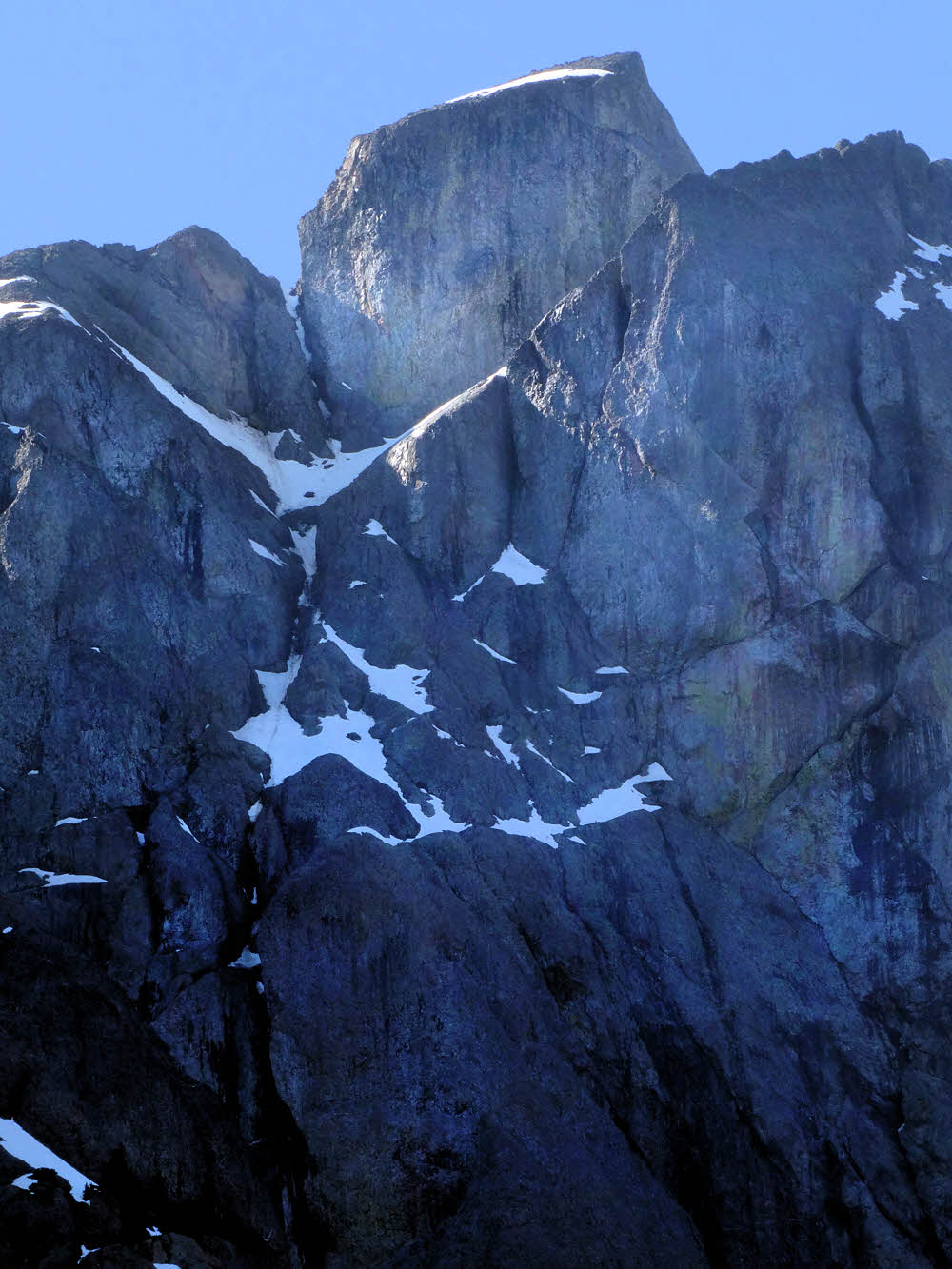
Mountain goats are not native to the Olympic Mountains of Washington State, and they also are not rare. They are not safe to be around either. About five years back a man was killed by one. Poked in the leg. Got an artery punctured. Bled to death. On a fairly busy trail.
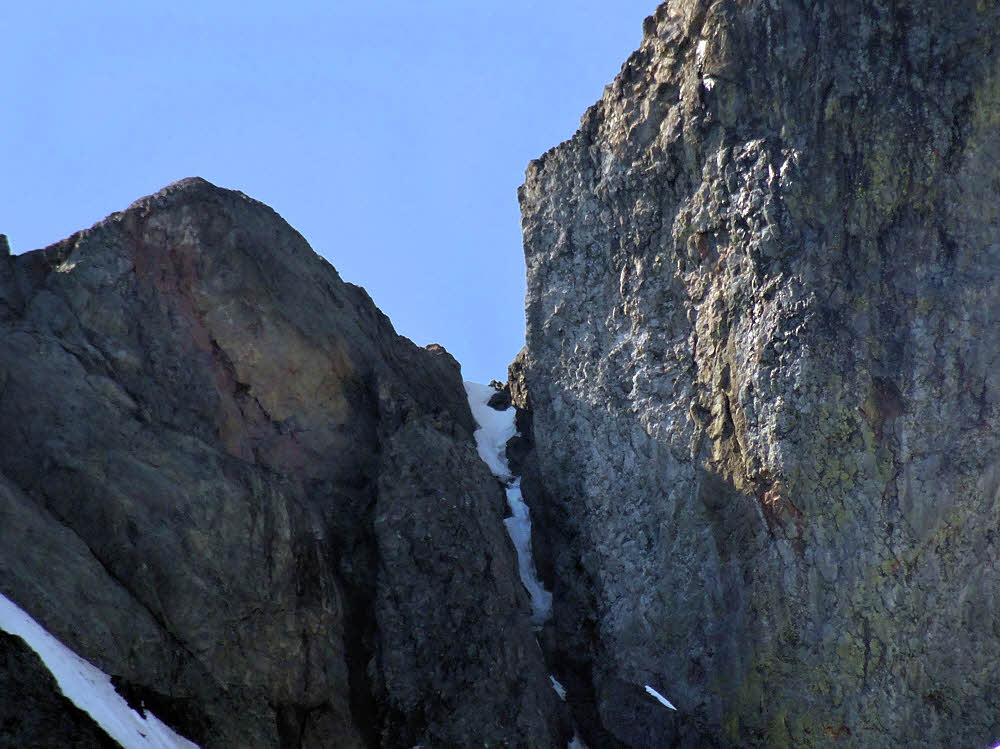
So, after I got settled in, ate, was ready to go poking around in the evening, then I saw my goat. It didn't get close to me, relatively speaking. But actually it did get too close, about 50 feet (about 15 m), which is way too close. And this wasn't some goat up on a rocky ledge. It was in the woods with me. It was casually, nonchalantly walking around, completely unconcerned.

The good part of my encounter that evening was that the goat didn't seem to be the least bit interested in me, but to be safe, I picked a spot about 200 feet (60 m) away, and urinated only in that one spot. The goat didn't seem overly impressed by that either. I guess it wasn't after salt. But if it was, it was welcome to it, and couldn't use salt lust as an excuse to come over and get belligerent with me. And also I chucked a rock or two in its general direction as it passed by my camp. Just to clearly establish what our relationship was going to be like. So far so good. The goat trotted off into the woods.

Home Lake from Constance Pass.
Around dusk I went out to the adjoining meadow and sat on a rock. Yep. The goat came back. I chucked more rocks. It seemed puzzled, but steered an arcing course around me, keeping large boulders between itself and me. Then it appeared over on my right, clomping its way up the back side of another boulder and peering at me. Chuck. Chuck. I gave it two more rocks, and that was about the end of it.

No, I wasn't trying to hit it or to hurt it, only to make a noise. The goat could see me throw, and could hear the rock hit 10 or 15 feet in front of it, and it knew what the sound of rocks was. Maybe it had had a few rock bonks on its noggin. I expect that most mountain goats experience that, naturally, so when it saw me unspring myself and then heard the clatter of my stone, I'm pretty sure that it knew that I wasn't in the mood for company, and likely wasn't a fun person to be around. At all.

So that was about that. Not much of a story to relate, but I'm desperately trying to fill in for not having any photos. Is it working yet? I'll probably never know.

Looking south from Constance Pass.
But that was only the first evening. The next day I had something real to do. I needed to make a pass at Constance. Constance the pass. And I did.

I'd seen the pass in 2003 and had not been back since. Previously I mentioned my long loop hike that took me up the Dosewallips River, over to the Elwha River, up to Hurricane Ridge, across to Deer Park, down to Slab Camp, down the Gray Wolf River, out of Olympic National Park and into the Olympic National Forest, then south along the Dungeness River, over the top of Constance Pass, and back to the Dosewallips River. Well, I did that, but hadn't been back since.

Creepy old guy who arrived at the pass when I did. And who eerily vanished from the pass at the exact moment I left it.
Things had changed a bit in 12 years.

View back north down the Dungeness valley.
The washed-out trail along the Gray Wolf was one thing. It's probably still possible to make the Park-to-Forest connection, but it would be dangerous. In 2003 I had to cross a sketchy log bridge. It was one of those ginormous logs you see in western Washington, about five feet (1.5 m) thick. Pretty easy to walk along. Even had a railing. But the north end, the far end, had been knocked off its footing by a flood. That end was also pointing a little downstream, and the whole log, railing and all, was partly rolled over toward its upstream side. A bit spooky.

Spooky because the water there flowed between two rock walls, and was deep. Not a place to try wading when there is no bridge at all. Downstream was chocked with fallen trees — sweepers — trees whose branches cover the stream, waiting for a fallen, splashing, struggling hiker to come along, so they could catch him, push him under, hold him, and drown him. But not me. I'm not going there.

As it was, in 2003, with a log to cautiously creep over, well — that was spooky enough with deep water foaming just under my crawling self, and not sure if the log, big as it was, heavy as it was, might roll over and take me down. Though if I could pass through there again, I would.

A short way on from there the trail ends at a Forest Service road, and then it's a couple of miles of road walking but that is not bad. Once past that it's a nice stroll up the Dungeness River, which is about what ground I covered on this trip.

In 2003 I passed the sort of "camping" area at the upper end of the trail and continued halfway to Constance Pass. Up there I found a tall snag whose base was stuck between two boulders and was able to use it to hang my food. Choice, especially so because there was no other place to put my food. And because of what happened that night, I'm glad that I wasn't sleeping with my food.

There was no place to put my hammock either, but I got clever. About a half-mile (4/5 km) shy of Home Lake, beside and a bit below the trail, there was a giant boulder. At each end of it grew a tree. The two trees were small but stout — just exactly barely stout enough to support my hammock, so I slept there. My hammock was parallel to the valley wall, so night wind would be deflected by the hammock's fly, and the hammock was roughly 30 feet (10 m) off trail, downwind.
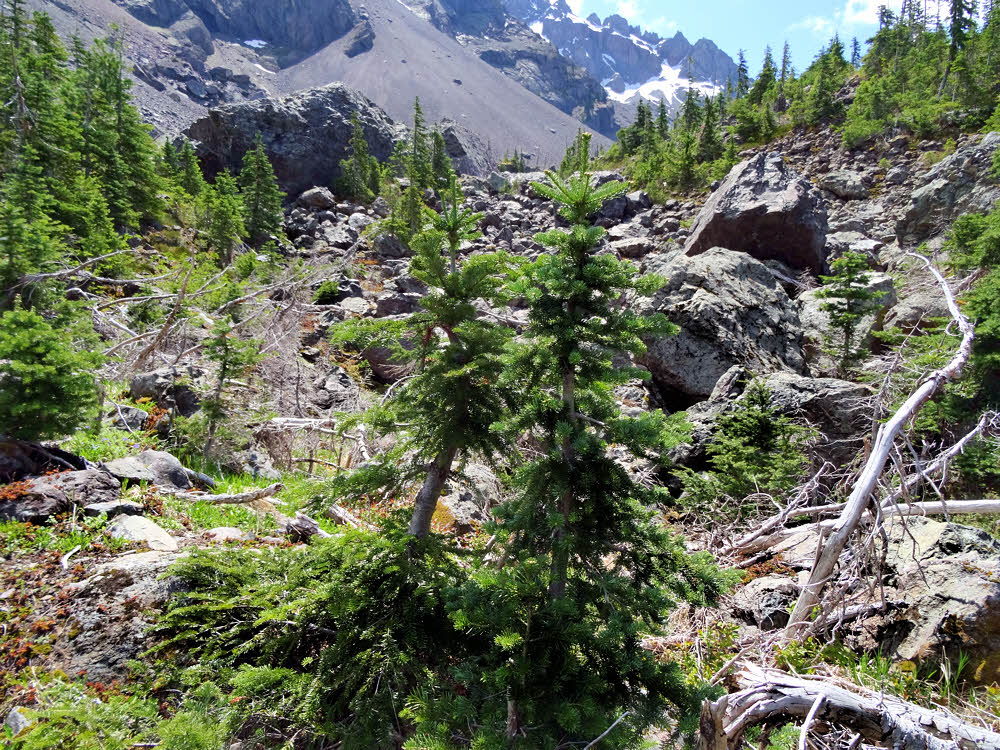
Good. As long as my support ropes held, but I'd only crash a couple of feet onto the boulder's flat top. So I set up camp on the rock. All was well and good and fine until after dark.

Until sometime after dark. I awoke in the dark. Fine. I do that. You do that. Everyone does that. The night was calm and silent. Perfect, so I snuggled in a bit and prepared to fall asleep again in due time, bit I didn't. Right away. And then I heard something coming my way.
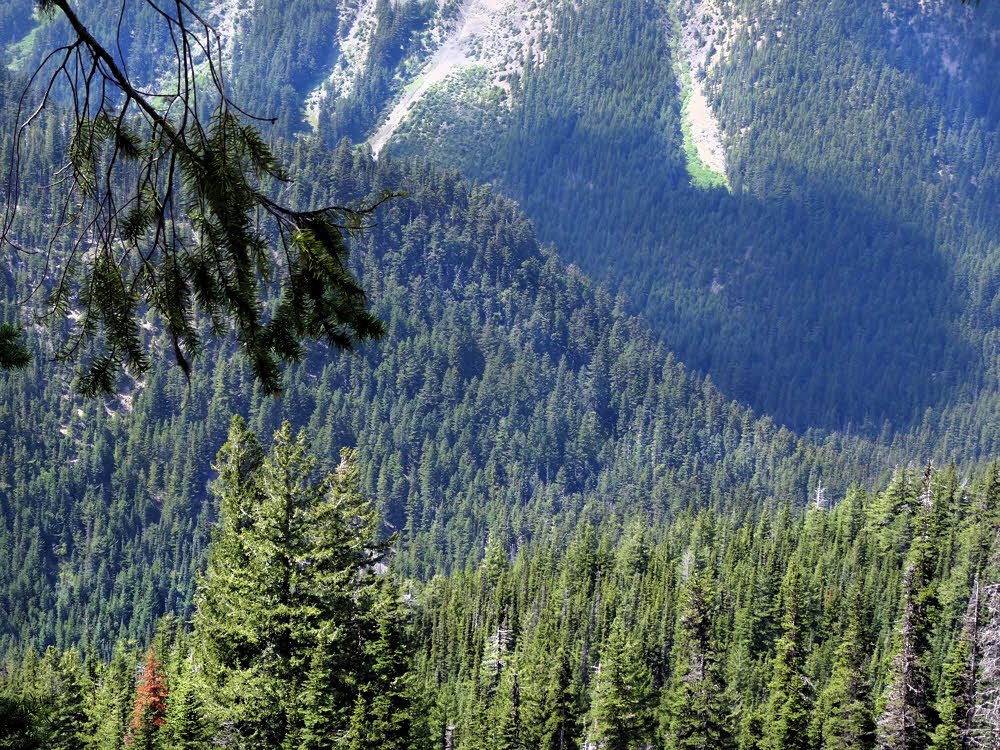
In the dark, inside a sleeping bag, inside a hammock, behind a rain fly you don't see much. You don't see anything. But you can still hear. I heard something. Coming down the trail. Something with hooves. The sound is distinctive. The little bell-like tinkle turning stones. The gentle clatter as one and another of them is kicked. The crunch-crunch. Delicate sounds. It was a hoofed animal walking down from the pass, from the direction of the pass, in the dark. Delightful, really. What a treat. At first.

Because that wasn't all. That animal — deer or elk or goat — well, it passed by. And I prepared to get sleepy and resume my rest, but then, a few minutes later, I heard the other sound — another animal — a different one. One with soft feet. Also passing by my camp, past supine, bundled, helpless me. An animal with soft feet, but not a perfectly poised animal because it too disturbed some of the trail's loose stone. Not with small kicks and hard crunches but with faint, very faint rearrangements of stones, here and there, under its soft foot-soles. And this scared the snot right clean out of me. I held my breath I didn't breathe I only listened and did not move at all and waited for what would happen next.
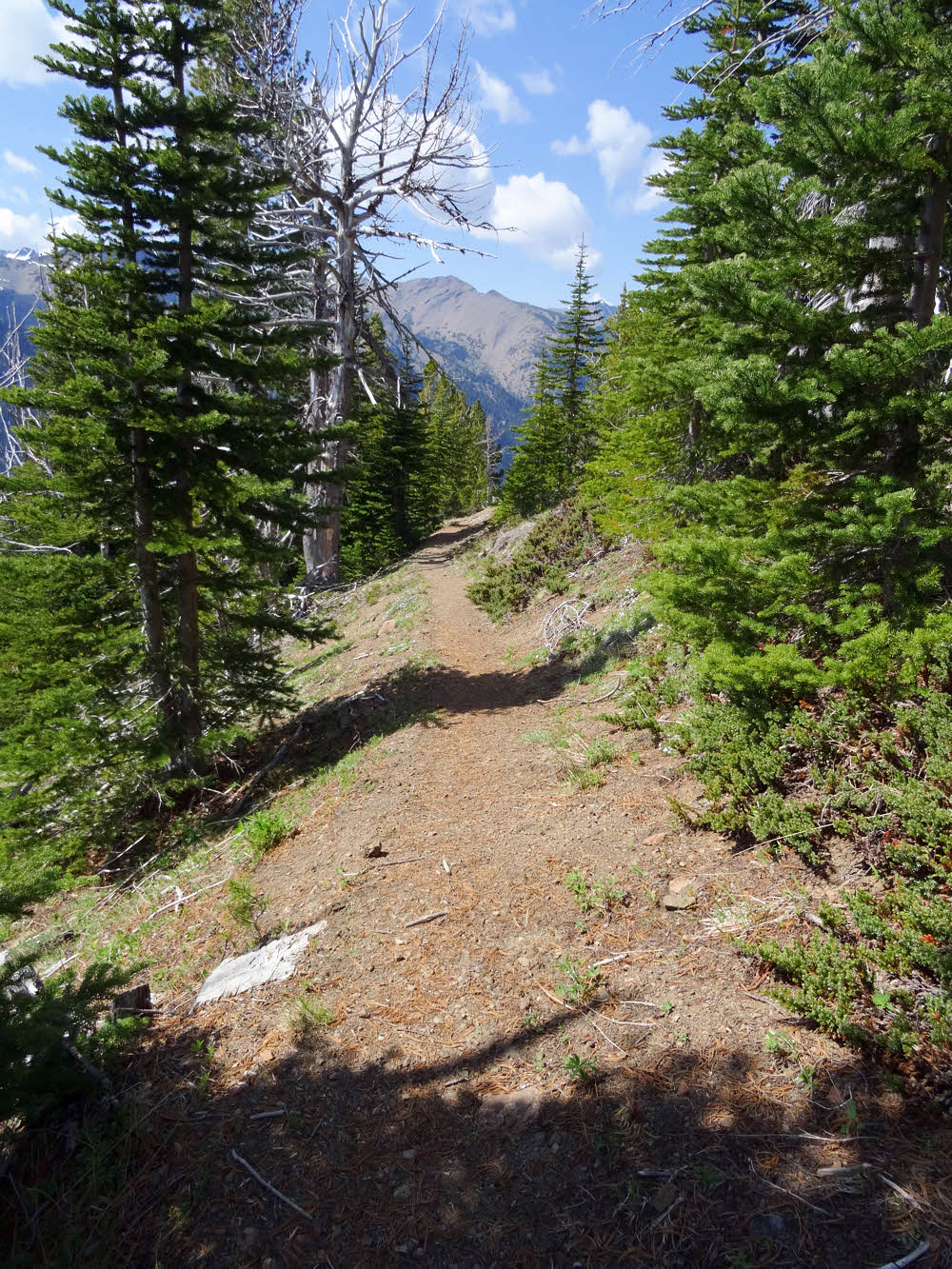
What happened next was that the animal — skunk or raccoon or coyote or lynx or bobcat or cougar or bear — kept walking. It came near and passed by and its sounds faded and were gone. I, lying off-trail, downslope and downwind, remained unnoticed. This was clear. Neither animal detected me. I know what happens when elk unexpectedly walk into my scent at night — they go nuts. They bark and stamp and stumble and stampede. I don't know what bears do, or cougars and I don't want to, but both animals passed by within feet of me and neither gave any hint that they knew I was there, and I am really truly glad for that. Startling elk is one thing and startling carnivores has to be something else. So I had an experience, one whose recollection is still razor sharp and crystal clear 13 years later. That's what Constance Pass means to me.

Meadow hut at my first night's camp.
So after I got up last year, I packed, and humped up the last mile or two of trail and went and looked across the top of Constance Pass, barely kissing it, after leaving my pack at little Home Lake, and after that I backtracked, passed back past my campsite, and headed for Buckhorn Mountain, for the Tubal Cain mine site, and for the trail head. Which is where we'll go next time.

Here's the general area. SE of Port Angeles, south of Sequim.

And here is my route — not long. Just right.
Part 1, Dungenessity.
Part 3, Plying The Tubal.
As always, Effort or Eff it. No sniveling then, eh?